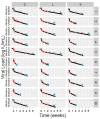HCV kinetic and modeling analyses indicate similar time to cure among sofosbuvir combination regimens with daclatasvir, simeprevir or ledipasvir
- PMID: 26907973
- PMCID: PMC5081285
- DOI: 10.1016/j.jhep.2016.02.022
HCV kinetic and modeling analyses indicate similar time to cure among sofosbuvir combination regimens with daclatasvir, simeprevir or ledipasvir
Abstract
Background & aims: Recent clinical trials of direct-acting-antiviral agents (DAAs) against hepatitis C virus (HCV) achieved >90% sustained virological response (SVR) rates, suggesting that cure often took place before the end of treatment (EOT). We sought to evaluate retrospectively whether early response kinetics can provide the basis to individualize therapy to achieve optimal results while reducing duration and cost.
Methods: 58 chronic HCV patients were treated with 12-week sofosbuvir+simeprevir (n=19), sofosbuvir+daclatasvir (n=19), or sofosbuvir+ledipasvir in three French referral centers. HCV was measured at baseline, day 2, every other week, EOT and 12weeks post EOT. Mathematical modeling was used to predict the time to cure, i.e., <1 virus copy in the entire extracellular body fluid.
Results: All but one patient who relapsed achieved SVR. Mean age was 60±11years, 53% were male, 86% HCV genotype-1, 9% HIV coinfected, 43% advanced fibrosis (F3), and 57% had cirrhosis. At weeks 2, 4 and 6, 48%, 88% and 100% of patients had HCV<15IU/ml, with 27%, 74% and 91% of observations having target not detected, respectively. Modeling results predicted that 23 (43%), 16 (30%), 7 (13%), 5 (9%) and 3 (5%) subjects were predicted to reach cure within 6, 8, 10, 12 and 13weeks of therapy, respectively. The modeling suggested that the patient who relapsed would have benefitted from an additional week of sofosbuvir+ledipasvir. Adjusting duration of treatment according to the modeling predicts reduced medication costs of 43-45% and 17-30% in subjects who had HCV<15IU/ml at weeks 2 and 4, respectively.
Conclusions: The use of early viral kinetic analysis has the potential to individualize duration of DAA therapy with a projected average cost saving of 16-20% per 100-treated persons.
Keywords: Duration of therapy; HCV; Mathematical modeling; SVR; Viral kinetics.
Copyright © 2016 European Association for the Study of the Liver. Published by Elsevier B.V. All rights reserved.
Conflict of interest statement
Disclosures: None of the authors has any financial interest or conflict of interest related to this research. Writing Assistance: None.
Figures



Similar articles
-
Efficacy and safety of 3-week response-guided triple direct-acting antiviral therapy for chronic hepatitis C infection: a phase 2, open-label, proof-of-concept study.Lancet Gastroenterol Hepatol. 2016 Oct;1(2):97-104. doi: 10.1016/S2468-1253(16)30015-2. Epub 2016 Jul 25. Lancet Gastroenterol Hepatol. 2016. PMID: 27917405 Free PMC article. Clinical Trial.
-
Sofosbuvir-Containing Regimens for Chronic Hepatitis C Are Successful in the Safety-Net Population: A Real-World Experience.Dig Dis Sci. 2016 Dec;61(12):3602-3608. doi: 10.1007/s10620-016-4340-x. Epub 2016 Oct 14. Dig Dis Sci. 2016. PMID: 27743164 Free PMC article.
-
Retreatment with sofosbuvir, ledipasvir, and add-on ribavirin for patients who failed daclatasvir and asunaprevir combination therapy.J Gastroenterol. 2017 Oct;52(10):1122-1129. doi: 10.1007/s00535-017-1328-z. Epub 2017 Mar 18. J Gastroenterol. 2017. PMID: 28315983
-
Efficacy and safety of direct acting antiviral regimens for hepatitis C virus and human immunodeficiency virus co-infection: systematic review and network meta-analysis.J Gastroenterol Hepatol. 2020 Sep;35(9):1477-1487. doi: 10.1111/jgh.15051. Epub 2020 Apr 15. J Gastroenterol Hepatol. 2020. PMID: 32246857
-
Ideal oral combinations to eradicate HCV: The role of ribavirin.J Hepatol. 2016 Jan;64(1):215-25. doi: 10.1016/j.jhep.2015.09.009. Epub 2015 Sep 26. J Hepatol. 2016. PMID: 26409316 Review.
Cited by
-
Predicting Early Viral Control under Direct-Acting Antiviral Therapy for Chronic Hepatitis C Virus Using Pretreatment Immunological Markers.Front Immunol. 2018 Feb 7;9:146. doi: 10.3389/fimmu.2018.00146. eCollection 2018. Front Immunol. 2018. PMID: 29467758 Free PMC article.
-
Impact of interferon-free antivirus therapy on lipid profiles in patients with chronic hepatitis C genotype 1b.World J Gastroenterol. 2017 Apr 7;23(13):2355-2364. doi: 10.3748/wjg.v23.i13.2355. World J Gastroenterol. 2017. PMID: 28428715 Free PMC article.
-
Advances in Parameter Estimation and Learning from Data for Mathematical Models of Hepatitis C Viral Kinetics.Mathematics (Basel). 2022 Jun 2;10(12):2136. doi: 10.3390/math10122136. Epub 2022 Jun 19. Mathematics (Basel). 2022. PMID: 36245949 Free PMC article.
-
Mathematical Analysis of Viral Replication Dynamics and Antiviral Treatment Strategies: From Basic Models to Age-Based Multi-Scale Modeling.Front Microbiol. 2018 Jul 11;9:1546. doi: 10.3389/fmicb.2018.01546. eCollection 2018. Front Microbiol. 2018. PMID: 30050523 Free PMC article. Review.
-
Assessment of lncRNA GAS5, lncRNA HEIH, lncRNA BISPR and its mRNA BST2 as serum innovative non-invasive biomarkers: Recent insights into Egyptian patients with hepatitis C virus type 4.World J Gastroenterol. 2020 Jan 14;26(2):168-183. doi: 10.3748/wjg.v26.i2.168. World J Gastroenterol. 2020. PMID: 31988583 Free PMC article.
References
MeSH terms
Substances
Grants and funding
LinkOut - more resources
Full Text Sources
Other Literature Sources
Miscellaneous

